Photo Essay from South Asia (2)
Irrigation in South Asia
Takashi Kurosaki
Last Revised August 27, 2001 (Japanese version: November 4, 1997)
South Asia is geographically diverse. Key to its diversity is rainfall and water. They are vital in agriculture. Especially in arid to semi-arid planes of the Indus valley of Pakistan and North to Central India, intensive agriculture is impossible without artificial irrigation. So let's look around rural South Asia, focusing on irrigation.
Irrigation uses water either from underground or from surface through canals. In this essay, underground water irrigation is discussed first, followed by surface water irrigation.
Persian Wheel
One traditional irrigation technology in South Asia is Persian wheel (Rahat in Urdu). Before this technology was invented, well irrigation was very inefficient.
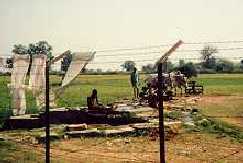 The photo was taken in a wheat field in Madhya Pradesh, India. First, wheels are put on the surface of groundwater and on the surface of land. Then, a belt with many, many water pots combines the two wheels. The vertical rotation is transferred into a horizontal rotation by a mechanic device. Finally, bullocks (or buffaloes or camels) drive the horizontal wheel. Then water pots on the belt automatically fetch water from underground and irrigate a field.
The photo was taken in a wheat field in Madhya Pradesh, India. First, wheels are put on the surface of groundwater and on the surface of land. Then, a belt with many, many water pots combines the two wheels. The vertical rotation is transferred into a horizontal rotation by a mechanic device. Finally, bullocks (or buffaloes or camels) drive the horizontal wheel. Then water pots on the belt automatically fetch water from underground and irrigate a field.
Poor animals don't like this boring work. To force animals to work, farmers sometimes blindfold the animals!
The invention of this technology improved agricultural productivity in medieval India substantially. But this device pump up water only about 12m deep. Since tubewell technology was introduced, Persian wheels have been disappearing very rapidly. I am sorry that the photo (taken in 1986) is not good. I am looking for another opportunity to take a better one, but so far, I was only able to visit abandoned Persian wheels.
Karez
In the periphery of deserts, Persian wheels cannot work because there is no groundwater readily available. In such dry areas, Karez, or Qanat is the main method of traditional irrigation. This technology is famous for Iran and Central Asia to irrigate orchards. You can find this in Baluchistan Province, Pakistan.
On the foothill of hills, snow-water is reserved in small aquifers. A horizontal underground tunnel is dug from the foothill aquifer to village areas. Its length is sometimes 20km long. For regular maintenance purpose, vertical holes are dug every 15m or so that connects the underground tunnel with the field surface. Karez is a system of this underground tunnel and these vertical holes.
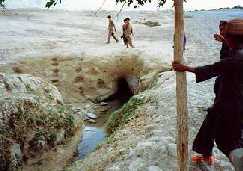 This is a photo of Karez exit. There is suddenly a water fountain in the desert. The water irrigates the oasis
This is a photo of Karez exit. There is suddenly a water fountain in the desert. The water irrigates the oasis
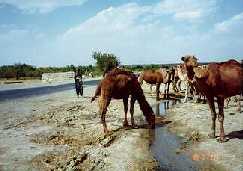 Camels drink water from the Karez. These two photos were taken in 1987 in the suburban area of Quetta.
Camels drink water from the Karez. These two photos were taken in 1987 in the suburban area of Quetta.
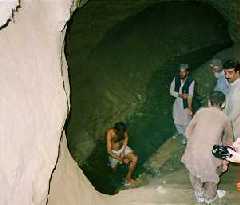 This is a photo taken in 1993 in Quetta city. In this case, the Karez output on the fields is over the town hamlets. Town people use the Karez water for living. They construct a special doorway going down to the horizontal tunnel. In the outside, the air is dry and hot; in the inside, you can find a cool water.
This is a photo taken in 1993 in Quetta city. In this case, the Karez output on the fields is over the town hamlets. Town people use the Karez water for living. They construct a special doorway going down to the horizontal tunnel. In the outside, the air is dry and hot; in the inside, you can find a cool water.
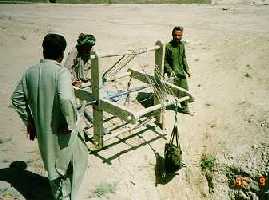 The regular maintenance of Karez is a heavy job. Every year, they have to clean the horizontal tunnel. Otherwise,sands from deserts will completely fill up the tunnel. The vertical holes are used for the maintenance work. Put a device around the hole to get out mud and workers go down to the horizontal tunnel. Because of this work, every vertical hole has a donut-like mud wall around it.
The regular maintenance of Karez is a heavy job. Every year, they have to clean the horizontal tunnel. Otherwise,sands from deserts will completely fill up the tunnel. The vertical holes are used for the maintenance work. Put a device around the hole to get out mud and workers go down to the horizontal tunnel. Because of this work, every vertical hole has a donut-like mud wall around it.
A politically strong power is needed to organize the heavy job of Karez maintenance. Recently, tubewells are becoming popular even in periphery of deserts. Karez agriculture in Pakistan is now disappearing rapidly.
Tubewells
Currently in South Asia, the most important technology for groundwater irrigation is the use of tubewells with pump. A metal tube (10 to 20cm diameter) is dug into the ground to reach aquifers. Then the water is pumped up either by electric or diesel engine. If the diameter is large or the aquifer is deep, high horse power is used and the investment cost goes up. Since "Green Revolution" of rice and wheat in South Asia, beginning from the late 1960s, profitability of farming goes up and the number of tubewell owning farmers increases very rapidly. The combination of improved seeds and stable irrigation from tubewells contributed to a significant increase in food production in South Asia.
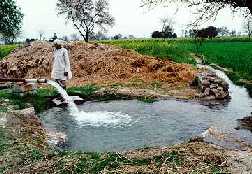 Water comes out from the tube continuously, as you can see from this photo. Farmers feed the water to their fields. The photo was taken in Haryana, India, March 1995. The green crop in the back is wheat and the yellow one is rape. Here, the pump is electric. Politicians introduced a popular tariff system "flat rate" for tubewell electricity. Regardless of the actual use of electricity, farmers pay a fixed money according to the horse power. This system is one of the reasons for inefficient use of electricity and irrigation water. Because of the flat rate, farmers have no incentive to save them.
Water comes out from the tube continuously, as you can see from this photo. Farmers feed the water to their fields. The photo was taken in Haryana, India, March 1995. The green crop in the back is wheat and the yellow one is rape. Here, the pump is electric. Politicians introduced a popular tariff system "flat rate" for tubewell electricity. Regardless of the actual use of electricity, farmers pay a fixed money according to the horse power. This system is one of the reasons for inefficient use of electricity and irrigation water. Because of the flat rate, farmers have no incentive to save them.
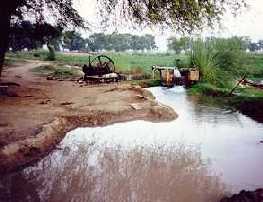 Tubewell technology is also popular in Pakistan side. One difference is that rural electrification in Pakistan is lagging behind India. The photo shows a disel-driven tubewell, which irrigated a huge cotton farm owned by a wealthy landlord in Vehari, Pakistan's Punjab.
Tubewell technology is also popular in Pakistan side. One difference is that rural electrification in Pakistan is lagging behind India. The photo shows a disel-driven tubewell, which irrigated a huge cotton farm owned by a wealthy landlord in Vehari, Pakistan's Punjab.
Surface Water Irrigation
Inundation Irrigation
A primitive technology to use surface water for agriculture is inundation irrigation. It is called Sailaaba in Urdu. Every year, river flooding water is fed into fields by special bands constructed just before flooding season. In Pakistan, this method is still in use on the Indus riverbed and in Baluchistan.
Small-Scale Canals
To make use of river water efficiently, dams and canals are necessary. In mountaneous areas of South Asia, small-scale canal systems with temprary barrages are observed. It is called Aabi in Urdu.
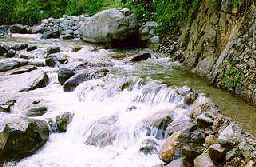 The photo was taken in Swat Valley, Northern Areas, Paksitan (1996). Water from a small river is dammed back by a small construct made of rocks and is fed into a small creek on the right hand side. As you can see, the system is very small with no civil engineering technology. Villagers themselves can manage the system.
The photo was taken in Swat Valley, Northern Areas, Paksitan (1996). Water from a small river is dammed back by a small construct made of rocks and is fed into a small creek on the right hand side. As you can see, the system is very small with no civil engineering technology. Villagers themselves can manage the system.
Large-Sacle Canals
The most important irrigation technology of South Asia today is large-scale canals. It is called Nahri in Urdu. Its history dates back into the 19th century when the British colonial government constructed a canal network systems. Especially high density networks were created on Indus and Ganges areas.
When India and Pakistan was partitioned in 1947, the Indus canal network was also divided. The Pakistan side re-created the system and the current Indus canal network of Pakistan is the largest irrigation system in the world. Water in the Indus is first dammed by a barrage of head works. The water is fed into a main canal, then into a main branch, a major distributory, and a minor distributory. Up to this stage, the government takes care of the management and maintenance. On the distributory canal, an outlet called Mogha is constructed, from which the water is fed into farmers' fields through a watercourse. A watercourse typically covers 20-30 ha to 100ha or more.
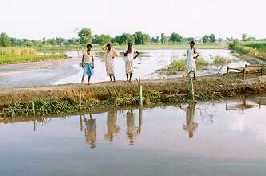 The photo on the left shows a distributory in Bahawalnagar District, Pakistan's Punjab, 1996. Although the maintenance of a distributory is the provincial government's responsibility, farmers voluntarily repaired the bank damaged by a sudden, heavy rain. The cooperative behavior by these farmers is not found everywhere, though.
The photo on the left shows a distributory in Bahawalnagar District, Pakistan's Punjab, 1996. Although the maintenance of a distributory is the provincial government's responsibility, farmers voluntarily repaired the bank damaged by a sudden, heavy rain. The cooperative behavior by these farmers is not found everywhere, though.
 In this photo on the right, a big farmer illegally cut the bank of another distributory canal to irrigate his own sugarcane fields. The cut on the bank is on the center. There is an official Mogha just close to the cut (left side). This greedy farmer illegally cut the bank because the water inflow from the official outlet is not enough. But due to this action, tail-end farmers will suffer a lot. In this case, tail-end farmers seem to be politically powerless, whereas the sugarcane farmer is an influential villager.
In this photo on the right, a big farmer illegally cut the bank of another distributory canal to irrigate his own sugarcane fields. The cut on the bank is on the center. There is an official Mogha just close to the cut (left side). This greedy farmer illegally cut the bank because the water inflow from the official outlet is not enough. But due to this action, tail-end farmers will suffer a lot. In this case, tail-end farmers seem to be politically powerless, whereas the sugarcane farmer is an influential villager.
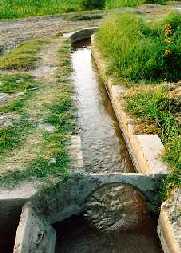 To ensure efficient use of water, canal lining is implemented, This photo shows a Mogha and a watercourse that is completely lined with concrete. But this method is very expensive. Main canals and distributory canals are not lined.
To ensure efficient use of water, canal lining is implemented, This photo shows a Mogha and a watercourse that is completely lined with concrete. But this method is very expensive. Main canals and distributory canals are not lined.
Salinity and Waterlogging
Bad management of canal irrigation not only results in water wastage, but also in the degradation of soils. In Pakistan where rainfall is absolutely small, canal irrigation without adequate drainage leads to an raise of aquifers due to water leakage. Strong sunshine pulls saline elements in the groundwater to the ground surface. Then some of the farmland is waterlogged, and others suffer from salinity. Currently, a huge acreage of irrigated land in Pakistan is damaged by waterlogging and salinity. Both decreases the land productivity substantially. At extreme cases, the land becomes barren.
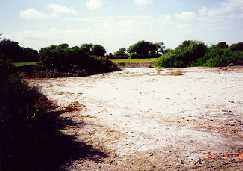 The photo on the right shows a field in Sind Province, Pakistan, where salinity affects its agriculture significantly. It was taken in Summer. Nevertheless, you can see white, snow-like powder in the field. It is soil. To prevent these two types of land degradation, a big project is going on in Pakistan to reduce the aquifer level.
The photo on the right shows a field in Sind Province, Pakistan, where salinity affects its agriculture significantly. It was taken in Summer. Nevertheless, you can see white, snow-like powder in the field. It is soil. To prevent these two types of land degradation, a big project is going on in Pakistan to reduce the aquifer level.
Back to Mariamma's Homepage (Information on South Asia): HOME; English Index
Back to Tak's University Homepage
 The photo was taken in a wheat field in Madhya Pradesh, India. First, wheels are put on the surface of groundwater and on the surface of land. Then, a belt with many, many water pots combines the two wheels. The vertical rotation is transferred into a horizontal rotation by a mechanic device. Finally, bullocks (or buffaloes or camels) drive the horizontal wheel. Then water pots on the belt automatically fetch water from underground and irrigate a field.
The photo was taken in a wheat field in Madhya Pradesh, India. First, wheels are put on the surface of groundwater and on the surface of land. Then, a belt with many, many water pots combines the two wheels. The vertical rotation is transferred into a horizontal rotation by a mechanic device. Finally, bullocks (or buffaloes or camels) drive the horizontal wheel. Then water pots on the belt automatically fetch water from underground and irrigate a field. This is a photo of Karez exit. There is suddenly a water fountain in the desert. The water irrigates the oasis
This is a photo of Karez exit. There is suddenly a water fountain in the desert. The water irrigates the oasis Camels drink water from the Karez. These two photos were taken in 1987 in the suburban area of Quetta.
Camels drink water from the Karez. These two photos were taken in 1987 in the suburban area of Quetta. This is a photo taken in 1993 in Quetta city. In this case, the Karez output on the fields is over the town hamlets. Town people use the Karez water for living. They construct a special doorway going down to the horizontal tunnel. In the outside, the air is dry and hot; in the inside, you can find a cool water.
This is a photo taken in 1993 in Quetta city. In this case, the Karez output on the fields is over the town hamlets. Town people use the Karez water for living. They construct a special doorway going down to the horizontal tunnel. In the outside, the air is dry and hot; in the inside, you can find a cool water. The regular maintenance of Karez is a heavy job. Every year, they have to clean the horizontal tunnel. Otherwise,sands from deserts will completely fill up the tunnel. The vertical holes are used for the maintenance work. Put a device around the hole to get out mud and workers go down to the horizontal tunnel. Because of this work, every vertical hole has a donut-like mud wall around it.
The regular maintenance of Karez is a heavy job. Every year, they have to clean the horizontal tunnel. Otherwise,sands from deserts will completely fill up the tunnel. The vertical holes are used for the maintenance work. Put a device around the hole to get out mud and workers go down to the horizontal tunnel. Because of this work, every vertical hole has a donut-like mud wall around it. Water comes out from the tube continuously, as you can see from this photo. Farmers feed the water to their fields. The photo was taken in Haryana, India, March 1995. The green crop in the back is wheat and the yellow one is rape. Here, the pump is electric. Politicians introduced a popular tariff system "flat rate" for tubewell electricity. Regardless of the actual use of electricity, farmers pay a fixed money according to the horse power. This system is one of the reasons for inefficient use of electricity and irrigation water. Because of the flat rate, farmers have no incentive to save them.
Water comes out from the tube continuously, as you can see from this photo. Farmers feed the water to their fields. The photo was taken in Haryana, India, March 1995. The green crop in the back is wheat and the yellow one is rape. Here, the pump is electric. Politicians introduced a popular tariff system "flat rate" for tubewell electricity. Regardless of the actual use of electricity, farmers pay a fixed money according to the horse power. This system is one of the reasons for inefficient use of electricity and irrigation water. Because of the flat rate, farmers have no incentive to save them. Tubewell technology is also popular in Pakistan side. One difference is that rural electrification in Pakistan is lagging behind India. The photo shows a disel-driven tubewell, which irrigated a huge cotton farm owned by a wealthy landlord in Vehari, Pakistan's Punjab.
Tubewell technology is also popular in Pakistan side. One difference is that rural electrification in Pakistan is lagging behind India. The photo shows a disel-driven tubewell, which irrigated a huge cotton farm owned by a wealthy landlord in Vehari, Pakistan's Punjab. The photo was taken in Swat Valley, Northern Areas, Paksitan (1996). Water from a small river is dammed back by a small construct made of rocks and is fed into a small creek on the right hand side. As you can see, the system is very small with no civil engineering technology. Villagers themselves can manage the system.
The photo was taken in Swat Valley, Northern Areas, Paksitan (1996). Water from a small river is dammed back by a small construct made of rocks and is fed into a small creek on the right hand side. As you can see, the system is very small with no civil engineering technology. Villagers themselves can manage the system. The photo on the left shows a distributory in Bahawalnagar District, Pakistan's Punjab, 1996. Although the maintenance of a distributory is the provincial government's responsibility, farmers voluntarily repaired the bank damaged by a sudden, heavy rain. The cooperative behavior by these farmers is not found everywhere, though.
The photo on the left shows a distributory in Bahawalnagar District, Pakistan's Punjab, 1996. Although the maintenance of a distributory is the provincial government's responsibility, farmers voluntarily repaired the bank damaged by a sudden, heavy rain. The cooperative behavior by these farmers is not found everywhere, though. In this photo on the right, a big farmer illegally cut the bank of another distributory canal to irrigate his own sugarcane fields. The cut on the bank is on the center. There is an official Mogha just close to the cut (left side). This greedy farmer illegally cut the bank because the water inflow from the official outlet is not enough. But due to this action, tail-end farmers will suffer a lot. In this case, tail-end farmers seem to be politically powerless, whereas the sugarcane farmer is an influential villager.
In this photo on the right, a big farmer illegally cut the bank of another distributory canal to irrigate his own sugarcane fields. The cut on the bank is on the center. There is an official Mogha just close to the cut (left side). This greedy farmer illegally cut the bank because the water inflow from the official outlet is not enough. But due to this action, tail-end farmers will suffer a lot. In this case, tail-end farmers seem to be politically powerless, whereas the sugarcane farmer is an influential villager. To ensure efficient use of water, canal lining is implemented, This photo shows a Mogha and a watercourse that is completely lined with concrete. But this method is very expensive. Main canals and distributory canals are not lined.
To ensure efficient use of water, canal lining is implemented, This photo shows a Mogha and a watercourse that is completely lined with concrete. But this method is very expensive. Main canals and distributory canals are not lined. The photo on the right shows a field in Sind Province, Pakistan, where salinity affects its agriculture significantly. It was taken in Summer. Nevertheless, you can see white, snow-like powder in the field. It is soil. To prevent these two types of land degradation, a big project is going on in Pakistan to reduce the aquifer level.
The photo on the right shows a field in Sind Province, Pakistan, where salinity affects its agriculture significantly. It was taken in Summer. Nevertheless, you can see white, snow-like powder in the field. It is soil. To prevent these two types of land degradation, a big project is going on in Pakistan to reduce the aquifer level.